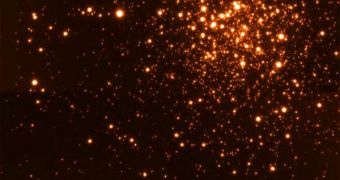Astronomers believe that, many years ago, when our galaxy was still in its infancy, it collided with a dwarf cousin, giving birth to a host of processes, including the development of a stellar cluster. As the Milky Way went on to grow to the impressive sizes it has today, the “fossilized” stellar cluster endured and continues to do so to this day. Now, it provides scientists with much-needed clues as to the origin and development of our galaxy and of the troubled times it faced before it became this enormous behemoth, Space reports.
The globular cluster goes by the name of Terzan 5 and is located in the central bulge that makes up the core of the Milky Way. This bulge can be noticed in images of our galaxy's flattened disk, as the protrusions that form above and below the galactic plane. The structure is nothing more than a large collection of stars, which are held together by interacting gravity forces. Such a formation can host up to 1 million stars, though smaller clusters, featuring only 10,000 such celestial bodies, have been observed. Until now, about 150 clusters have been discovered in the Milky Way. All of them are ancient, by cosmic standards.
Experts believe that each of the structures appeared at around the same time a massive cloud of gas and dust did. The widely-accepted idea about stellar formation at this point is that the bodies are created when portions of cosmic gas become so heavy that they fall under their own gravitational pull, collapsing and igniting as they do so. It would therefore make sense that stars in these clusters appeared out of massive clouds of gas, mostly hydrogen.
In a new paper published in the November 26 issue of the respected scientific journal Nature, experts at the European Southern Observatory's (ESO) Very Large Telescope (VLT) argue that this is not the formation mechanism for Terzan 5. As proof, they show measurements which indicate that the stars in the cluster are not of the same age and composition, as one would expect from celestial bodies with the same origin. “The history of the Milky Way is encoded in its oldest fragments, globular clusters and other systems of stars that have witnessed the entire evolution of our galaxy,” explains Francesco Ferraro, a scientist at the University of Bologna, who lead the team that analyzed the peculiar cluster.

 14 DAY TRIAL //
14 DAY TRIAL //